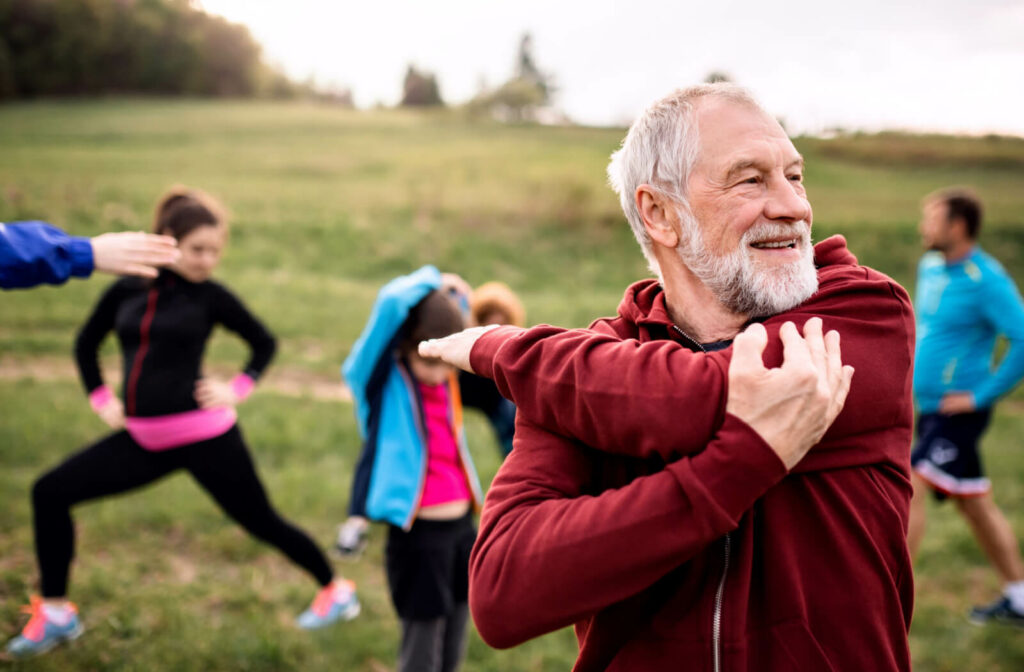Joint pain is common as you age. Having pain when you move can make it difficult to perform even the most basic of tasks, such as getting out of bed. Cedar Creek’s Senior Living Community can support your needs by providing help with activities of daily living.
Loss of bone density and muscle mass starts around age 30, and pressure and joint pain are often felt in your 50s and after. To keep joints as healthy as possible and maintain function, you can safeguard them as you age with exercise, managing your weight, stretching, and adopting lifestyle changes.
8 Ways to Keep Joints Healthy
People can experience stiff and painful joints from osteoarthritis, which is wear and tear of cartilage, or other causes, such as an autoimmune disease.
Rheumatoid arthritis is an autoimmune disease where the body’s immune system attacks healthy joint tissue, causing painful swelling. Other causes of joint pain can include joint-related injury, fractures, lack of vitamin D, or hypothyroidism.
Fortunately, there are some things that you can do to keep your joints healthy and reduce your risk of joint pain as you age:
Exercise Regularly
Bones, joints, and muscles support your body as you move. Keeping them healthy and strong means you can remain physically active and manage daily activities.
Muscle strengthening exercises can reinforce the ligaments around the joints and reduce functional limitations. You can start these at any age; it’s never too late. However, always consult your doctor or physical therapist before you begin any exercise program.
Regular physical activity can include low-impact exercises such as walking, biking, and swimming. These types of exercises typically produce less joint strain and can reduce your risk of injury.
Some muscle soreness can be expected, but if you develop joint pain after exercising, see your doctor to rule out something more serious.
Manage Your Weight
You gain weight when you consume more calories than you burn. When you’re overweight, there is more strain on weight-bearing joints, such as the knees and hips.
And when you’re underweight, you lack muscle mass, leading to weak and unstable joints. Exercise and diet can help maintain a healthy weight.
Stretch
Stretching is often underrated but so important. When you don’t stretch the muscles, it can increase your risk of strain and injury.
Warm-ups before exercise at a lower intensity prepare the same muscles for when you exercise. And cool-down stretches ease sore joints and can prevent injury post-workout. Stretching can be done for as little as 5 minutes.
As you get older, stretching is even more vital as joints become less resilient. Yoga and pilates offer stretching with a range of motion, is low-impact and can increase flexibility and balance.
Eat a Healthy Diet
A healthy, well-balanced diet can promote ideal weight and reduce inflammation. This includes a mix of fruits, vegetables, protein, whole grains, and healthy fats.
It also means limiting foods high in sugar, refined carbohydrates, and salt. A healthy diet can keep inflammation under control, allow for fluid movement, and reduce joint pain.
Studies show eating a Mediterranean diet rich in anti-inflammatory foods can reduce inflammation and improve joint pain. They also show that it can protect against weight gain, fracture risk, and disability.
Get Your Vitamin D
Vitamin D regulates the body’s use of calcium and phosphorus. Studies show that low levels of vitamin D (vitamin D deficiency) are more likely to cause joint pain.
You can get vitamin D from foods, sunlight, and supplements. Always consult your doctor on the recommended daily dose when taking vitamins to prevent vitamin D toxicity.
Quit Smoking
Smoking can increase inflammation in the body. People who smoke complain of more pain in their back, neck, arms, and legs compared to people who don’t smoke.
Drink More Water
Synovial fluid found in the joints throughout your body lubricates the joints and cushions the bone. 70–80% of joint cartilage is made of water.
When the body is dehydrated, it can take water from other areas, including the cartilage. This reduces lubrication, increases friction, and causes joint pain.
When you skip the sugary drinks and opt for water, the synovial fluid can provide nutrition, shock absorption, lubrication, and cushion the joints. When your body is hydrated, your tendons, ligaments, and muscles are less susceptible to injury.
Maintain Good Posture
Posture is the position of your body when you stand, sit, or lie down. Good posture is the alignment of your bones, muscles, joints, and other body parts.
Poor posture can lead to incorrect muscle development, joint degeneration, joint pain, and unbalance. When you have good posture, your muscles use less energy and have less fatigue, which prevents strain, muscle overuse, and joint pain.
Cedar Creek Senior Living Community Can Meet Your Needs
Don’t wait until your joints begin to ache before you take proactive steps to keep joints healthy as you age.
Cedar Creek Senior Living can support your needs and ensure you stay active, maintain independence, and focus on providing a well-balanced and healthy lifestyle.
Schedule a tour to see what our community has to offer.



